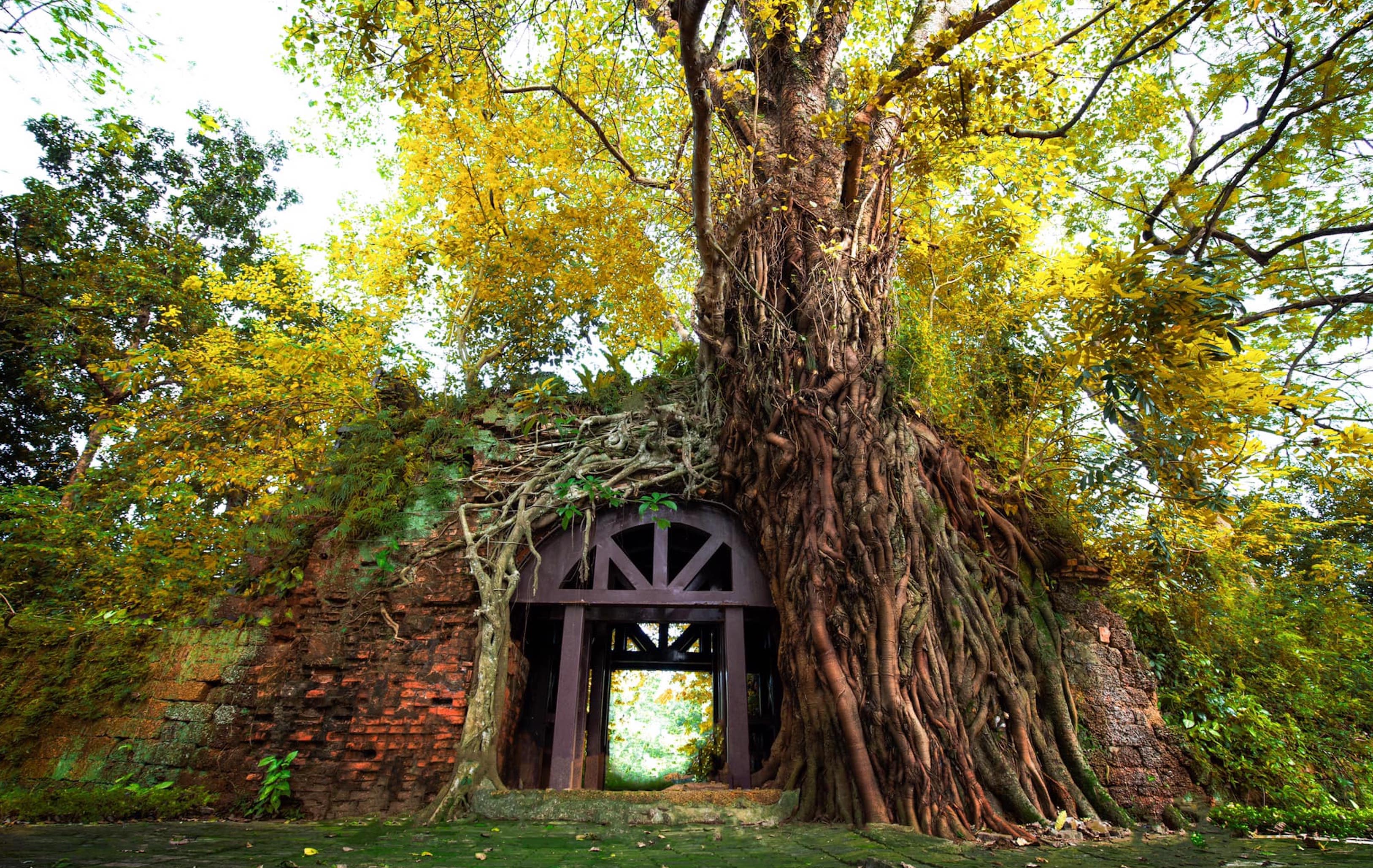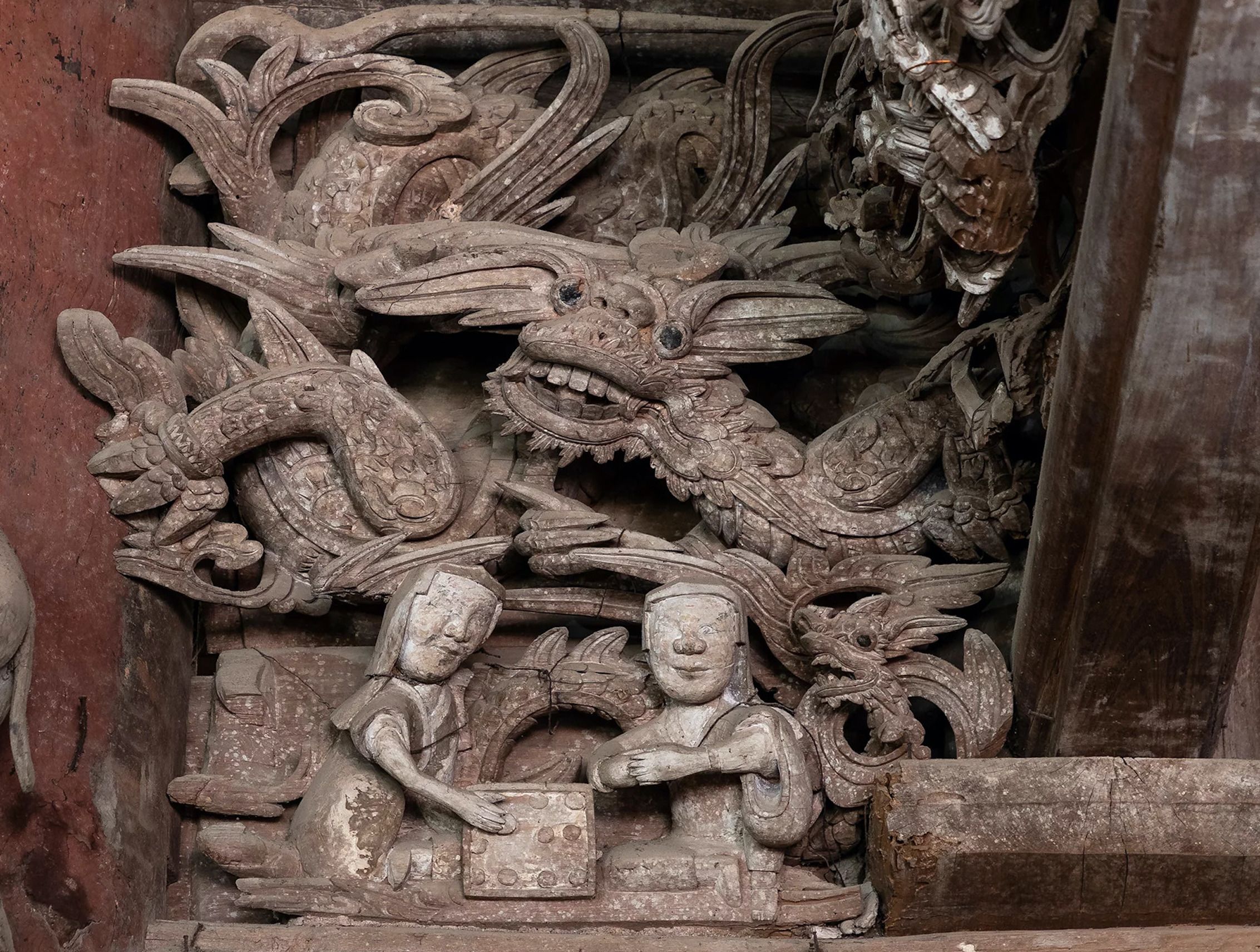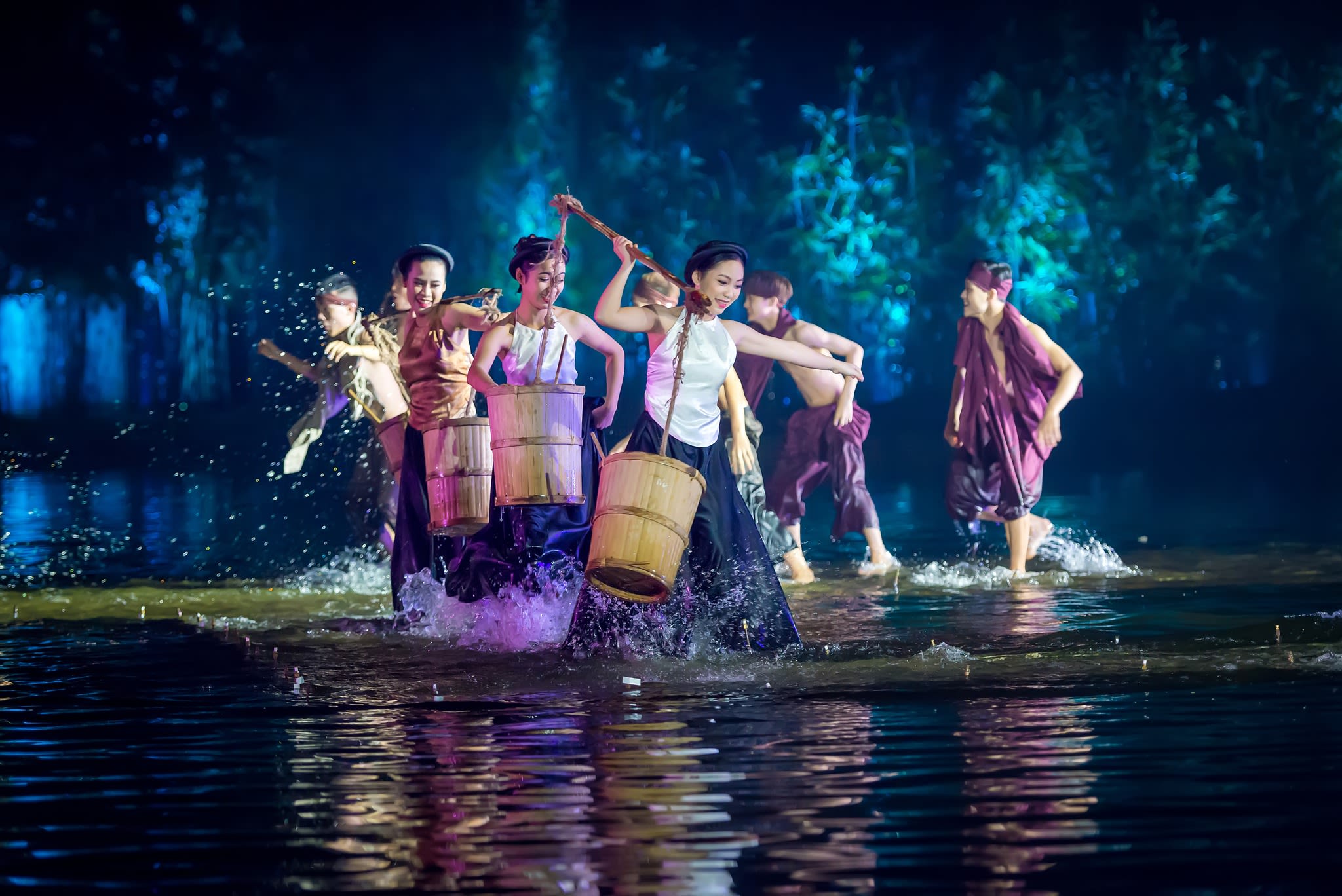Awakening the heritage of the “white cloud land”

In the capital of Hanoi, besides the Thang Long culture, there is also the Xu Doai culture, which is believed to be majestic like the Ba Vi mountains. Xu Doai culture merges with Thang Long culture, making the capital’s culture even richer. Amid the general culture of Hanoi, Xu Doai culture still retains its own characteristics, as it has done for thousands of years. Its value has been preserved and promoted, becoming an important resource for building the cultural industry.
The land of heritage
Xu Doai is the word referring to the land west of the capital, where Ba Vi peak has white clouds all year round. Poet Quang Dung, a son of this land, wrote: “I miss Xu Doai with white clouds/ Do you ever miss it?” In Vietnamese culture, not every land is considered a civilised land. Civilised land is used to refer to lands with long-standing historical-cultural traditions, lands that have seen many famous people who made great contributions to the country. Xu Doai is one of the few lands that has been considered a civilised region.
For a long time, Xu Doai belonged to former Ha Tay Province, so many people identified Ha Tay with Xu Doai. But in fact, Ha Tay includes several localities belonging to Xu Doai and a number of localities belonging to Son Nam Thuong. Xu Doai used to be a large area located to the west of Thang Long Citadel. After many administrative changes, the area of former Xu Doai now corresponds to the administrative boundaries of the districts of Quoc Oai, Thach That, Dan Phuong, Hoai Duc, Ba Vi, and Son Tay Town and a part of the provinces of Vinh Phuc and Phu Tho today.
After many administrative changes, the area of former Xu Doai now corresponds to the administrative boundaries of the districts of Quoc Oai, Thach That, Dan Phuong, Hoai Duc, Ba Vi, and Son Tay Town and a part of the provinces of Vinh Phuc and Phu Tho today.
Xu Doai is identified as the cradle of ancient Vietnamese civilisation, where there is a legend about Tan Vien Son Thanh, one of the four immortals of the Vietnamese people. The legendary stories about Tan Vien Son Thanh are associated with the Hung King era, the beginning of Vietnamese history.
Along with the development of history, Xu Doai has become a cultural land, the birthplace of many heroes and talented people of the country such as Kings Phung Hung, Ngo Quyen, Grand Tutor To Hien Thanh, Third Rank Scorer Giang Van Minh, and Laureate Bung Phung Khac Khoan.

The cultural depth of Xu Doai is also reflected in the number of monuments and heritages. Xu Doai concentrates a series of special national relics: Thay Pagoda, So Communal House (Quoc Oai District); Tay Phuong Pagoda (Thach That District); Hat Mon Temple, Tuong Phieu Communal House, and Ha Hiep Communal House (Phuc Tho District); Tay Dang communal house (Ba Vi District); and Dai Phung communal house (Dan Phuong district). Besides their historical value, these works are also “museums” of traditional architecture and sculpture; at the same time, they are also places to preserve many beautiful features of ancient Vietnamese villages, most notably the communal house system.
Xu Doai also has “unique” relics, such as Son Tay Citadel — the only laterite citadel in Southeast Asia; Duong Lam ancient village — one of two ancient villages in the country recognised as a National Architectural and Artistic Relic; Mia Pagoda (Son Tay town) —with 287 worship statues, currently holding the Vietnamese record for the largest number of Buddhist statues in a pagoda; and Son Tay Temple of Literature — a place to honour the tradition of studiousness and mandarin examinations in Doai, the relic system worshiping Tan Vien Son Thanh.
The charm of the roof of Tay Phuong Pagoda (Thach That district). Photo: Le Thanh
The charm of the roof of Tay Phuong Pagoda (Thach That district). Photo: Le Thanh
Xu Doai is also home to many valuable intangible cultural heritages, Notably, the worship of Tan Vien Son Thanh covers a large area at the foot of Tan Vien Mountain, Hat Mon Temple Festival (Phuc Tho District), Va Temple Festival (Son Tay Town), Do singing (Quoc Oai District), Trong Quan singing (Phuc Tho District), Chang Son water puppetry, Binh Phu water puppetry (Thach That District), Muong dance in Van Hoa Commune (Ba Vi District), Ngai Cau ca tru (Hoai Duc District), Thuong Mo ca tru (Dan Phuong District), and so on. In particular, Xu Doai is famous for many handicraft villages.
Professor Vu Minh Giang, Vice President of the Vietnam Historical Science Association, affirmed: “Xu Doai is a miniature picture of Vietnamese culture, but contains unique features that cannot be found anywhere else. Xu Doai culture is a priceless treasure in the flow of Vietnamese culture.”
Preserving identity in new context
The geographical boundary expansion of Hanoi has enriched the culture of the capital city without diluting the identity of the Doai region, which has even been lifted to a new higher position.
During a thousand years of history, the Doai culture has always interacted with the Thang Long culture. Many cultural figures from the Doai region travelled to Thang Long to establish their careers and make great contributions to the development of the capital city and country. This connection is the origin of the folk saying:
A realm of brocade and flowers
Gazing inwards to the homeland of silk and outwards to the capital
A thousand years of culture unrivalled
Ha Tay and Hanoi, always together.
This saying talks about the parallels between the two major cultural regions, Thang Long and Doai, along with other cultural regions in the former Ha Tay Province.
This connection entered a new period in 2008 when Ha Tay Province and parts of Vinh Phu Province and Hoa Binh Province were merged into Hanoi.
Ancient wells create spaces with a strong rural atmosphere in Duong Lam Village, Son Tay Town. (Photo: Nina May)
Ancient wells create spaces with a strong rural atmosphere in Duong Lam Village, Son Tay Town. (Photo: Nina May)
The geographical boundary expansion of Hanoi has enriched the culture of the capital city without diluting the identity of the Doai region, which has even been lifted to a new higher position.
Before the merger, the former Ha Tay Province had 3,053 historical sites. The renovation of such sites received the province’s close attention, but its resources for the work were limited. Since the province merged with the capital, these difficulties have been resolved, with resources allocated by the city to localities to preserve the valuable heritages.
On April 8, 2022, the City People's Council issued Resolution No. 02/NQ-HDND supplementing the 5-year medium-term public investment plan for 2021-2025, allocating the 2022 financial plan to implement the Investment Plan for the construction and renovation of public schools to meet national standards, upgrading the health system, and renovating relics in the period of 2022-2025 and the following years and a number of basic construction projects of city-level spending.
According to Resolution No. 02/NQ-HDND, the city is spending up to 14,000 billion VND for the restoration of 579 projects. In which, the funding is combined with the capital allocated by localities and the city budget.
A series of relics of the Doai region have benefited from this resolution. Three groups of relics are prioritised for investment and restoration, including relics that are seriously degraded and at risk of collapse, those that have been recognised for having high value but facing degrading, and those that need to be promoted as destinations to boost tourism development.
Since Resolution No. 02/NQ-HDND was implemented, work has commenced on upgrading about 20 relics in Phuc Tho District. Thach That District has also achieved a similar number. Thanks to this investment resource, hundreds of relics of the Doai region have been restored to their ancient beauty.
Thay Pagoda in Quoc Oai District in the blooming season of cotton flowers. (Photo: Le Thanh)
Thay Pagoda in Quoc Oai District in the blooming season of cotton flowers. (Photo: Le Thanh)
Regarding intangible cultural heritage, thanks to the Project on General Inventory and Protection of Intangible Cultural Heritage of the Hanoi Department of Culture and Sports, intangible cultural heritages of the Doai region have been reviewed and identified, and proper conservation measures have also been deployed. Heritages that were once in danger of being lost, such as ‘trong quan’ folk singing in Phuc Tho and ‘do’ folk singing in Quoc Oai have been revived. The operation of the Binh Phu, Chang Son, and Thach Xa water puppetry troupes and Thuong Mo ‘ca tru’ (ceremonial singing) troupes have been revitalised.
As a researcher, musician, and traditional music performer who is famous for restoring ‘xam’ and some other traditional folk art forms, researcher and musician Nguyen Quang Long said that when it was merged with Hanoi — the cradle of Thang Long culture — many people feared that the culture of the Doai region would gradually be forgotten and faded. However, in the Doai region, traditional cultural features have received proper care for preservation and promotion.
Important resources for cultural industry
The Son Tay Ancient Citadel pedestrian streets (Son Tay town) has been operating for more than two years so far, and its appeal has never diminished. Many cultural and artistic performances are regularly held on the streets on weekends. The pedestrian streets are also a space for organising art exhibitions, handicrafts, folk games. All these activities turn the walking space around Son Tay Ancient Citadel into an attractive cultural and tourist space. On average, the walking space attracts about 10,000 visitors each night. On major holidays or when organising major events, the pedestrian streets around Son Tay Ancient Citadel attracts from 25,000 to 30,000 visitors. The activities of the pedestrian streets also help people earn more income, contributing to the development of the inner-city economy.
Chu Quyen Communal House, one of the famous communal houses. (Photo: Tran Trung Ha).
Chu Quyen Communal House, one of the famous communal houses. (Photo: Tran Trung Ha).
Implementing Resolution No. 09-NQ/TU of the Hanoi Party Committee on "Developing cultural industry in the capital in the 2021-2025 period, with orientation to 2030 and a vision to 2045", many cultural heritages of the land are being exploited, promoting their values and becoming important resources in developing cultural industry, with the pedestrian streets around Son Tay Citadel being one of the activities. Along with Son Tay Citadel, relics such as: Duong Lam Ancient Village, Thay Pagoda, Tay Phuong Pagoda, and Hat Mon Temple have all become attractive tourist destinations.
Peaceful and rustic life in the ancient village of Duong Lam (Photo: Nina May).
Peaceful and rustic life in the ancient village of Duong Lam (Photo: Nina May).
Intangible cultural heritages have been also “awakened” to participate in cultural industry development activities, particularly in forms such as festivals, folk performing arts, and cuisine. Vietnam’s first outdoor real-life show, “The Quintessence of Tonkin”, is a prime example of creativity that brings new values to folk arts.
“The Quintessence of Tonkin” features a grand stage, modern effects, and a cast of 200 actors. Set in the countryside of the Doai region, the show recreates the rural life of the past, from scenes of labour, production, and festivals to everyday life. This allows the audiences to clearly feel the simplicity and genuineness of Doai culture. Interwoven into these scenes are various forms of folk performing arts such as water puppetry and chau van (spiritual singing) performed by artist-farmers themselves. This has maintained the show’s appeal to audiences in recent years, especially among tourists.
“The Quintessence of Tonkin” recreates and honours the beauty of rural life. (Photo: Hanoi Tuan Chau Corporation)
“The Quintessence of Tonkin” recreates and honours the beauty of rural life. (Photo: Hanoi Tuan Chau Corporation)
In addition to the aforementioned heritages, the ‘gong’ performance art of the Muong ethnic people has been incorporated into many tourism tours. Other forms of folk performing arts such as water puppetry, ca tru (ceremonial singing), and hat do have been being presented on major stages. Moreover, craft villages like Chang Son (carpentry), Son Dong (statue carving), and Thach Xa (bamboo dragonfly making) have become both tourist destinations and producers of many handicraft products as souvenirs, generating significant economic value.
Despite facing numerous challenges, especially regarding manpower and solutions to transform heritage resources into cultural industry products, the cultural heritage of Doai has begun to be tapped in the right direction. This not only contributes to improving local residents' lives but also ensures better preservation of many heritages through cultural industry development, thereby fostering the enduring vitality of Doai culture.
Procession at Gia Festival in Hoai Duc District. (Photo: Pham Quoc Dung)
Procession at Gia Festival in Hoai Duc District. (Photo: Pham Quoc Dung)
So Temple (Quoc Oai District) is known as “the most beautiful temple in Doai region.” (Photo: Phan Huy)
So Temple (Quoc Oai District) is known as “the most beautiful temple in Doai region.” (Photo: Phan Huy)
Son Tay Citadel (Photo: Nina May)
Son Tay Citadel (Photo: Nina May)
Ancient wells create a distinctively rural atmosphere in the ancient village of Duong Lam (Son Tay Town). (Photo: Nina May)
Ancient wells create a distinctively rural atmosphere in the ancient village of Duong Lam (Son Tay Town). (Photo: Nina May)
Published: September 2024
Production Manager: Kieu Huong – Hong Minh
Content: Giang Nam
Design: Bao Minh
Photos: Nina May, Pham Quoc Dung, Tran Trung Ha, Le Thanh, Hanoi Tuan Chau Corporation









